February 2018 Wrapup
And now with the last day of February, what was that month like?
As before, we had a daily blog post. In this month I’m particularly proud of The Power of Hate, The Art Of Your Normal, and Monsters.
Our three regular segments – Weekly MTG, Game Pile and Story Pile – posts? Check!
T-Shirt design? Check, here’s DON’T NEED NO REASON, on Redbubble and Teepublic.
Game launched? Winston’s Archive, here at Invincible Ink and DriveThruCards! It’s a two-plus player drafting game where you’re both sorting books, full of silly joke book titles!
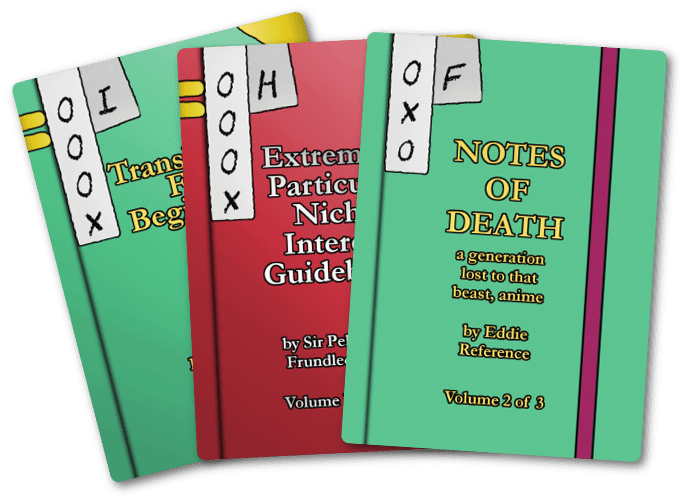
I really like Winston’s Archive because rather than use the drafting as part of some greater, more complicated play of the game, the game is the drafting. It’s also a useful system to understand, and taught me a lot about distribution in games and catch-up mechanisms. You should check it out!
Video? Episode 7 of Making Fun went up! Episode 8 will be coming, hopefully, and we’ll talk about some mechanics.
I launched my Patreon! This is a way you, the people who enjoy this work, can kick me a dollar or two a month in exchange for more content. This is a way you can request Micropodcasts, and partake in bundle sales, which I’m still getting a handle on.
In this month I also started some casual work for the uni (after some paperwork snafus, which led to more paperwork snafus), shifted my PhD to part-time, started to work on teaching game making at the uni, and spent more time with my family.
Game Pile: Bart Vs The Space Mutants
There used to be this show called The Simpsons on TV, and while a lot of ink has been spilled about the show – in some cases by Dan Olson, using it as a lens to examine masculinity, and Hari Kondabolu to celebrate the diversity and complexity of his culture, and by Super Eyepatch Wolf to examine the impact of a creative complex on the creative continuity – the institution, the brand of The Simpsons is basically cultural superstructure. You can’t really go wrong writing about the Simpsons, you just need to make sure you both point out the recent series sucks (what would I know) and glorify in its history.
We talk a lot about what the Simpsons is doing based on its creators, a sort of top-down perspective on the work from the narrowest point which coincidentally is a position shared by people who, like, make films and youtube channels, but you know a thing we don’t talk about much?
The Simpsons videogames.
Continue Reading →The Fear of the White Slave
The stories we tell, and how we tell them, shape our worldview. This isn’t ‘media programs you,’ not a satanic panic fear-of-the-demons-in-your-media, but something slower, more grinding, more insidious. There’s an acretion of the world around you as you pass over it, little bits of the everyday. Making everyone’s clothes show ads, we thought, would be about making sure you were always showing off the hash-tag brand. Turns out that it mostly just meant people saw ads on clothes as normal and not worth noticing any more.
It’s hard to turn that kind of ubiquity into money in a pragmatic one-on-one sense. It’s difficult to monetise a brand if the main job monetising it is to be everywhere all at once, you need a certain scale for that to have an impact. You need to be Pepsi, for example. What you can do with it, though, is reinforce an idea of what’s normal, and thousands of sources doing it all the time can do a lot to shape that idea of normal.
It’s Marketing Whiteness.
CW, gunna talk about slavery and fundamentalism and whiteness and dismiss the historicity of the Bible, which just gets some people up in a dander.
Continue Reading →The Power Of Hate
I like pigs.
It’s a weird thing, considering. Maybe it’s a childhood story of Babe. Maybe it’s after being raised in a weirdo Christian cult, I thought the ‘unclean’ label they got was a bit rough. Maybe it’s Asterix comics that made it look like the poor boars were on the losing side of things.
But I like pigs.
CW ahead for descriptions of war and some unpleasant ways we refer to history.
Continue Reading →Story Pile: My Two Pennies, Part IV
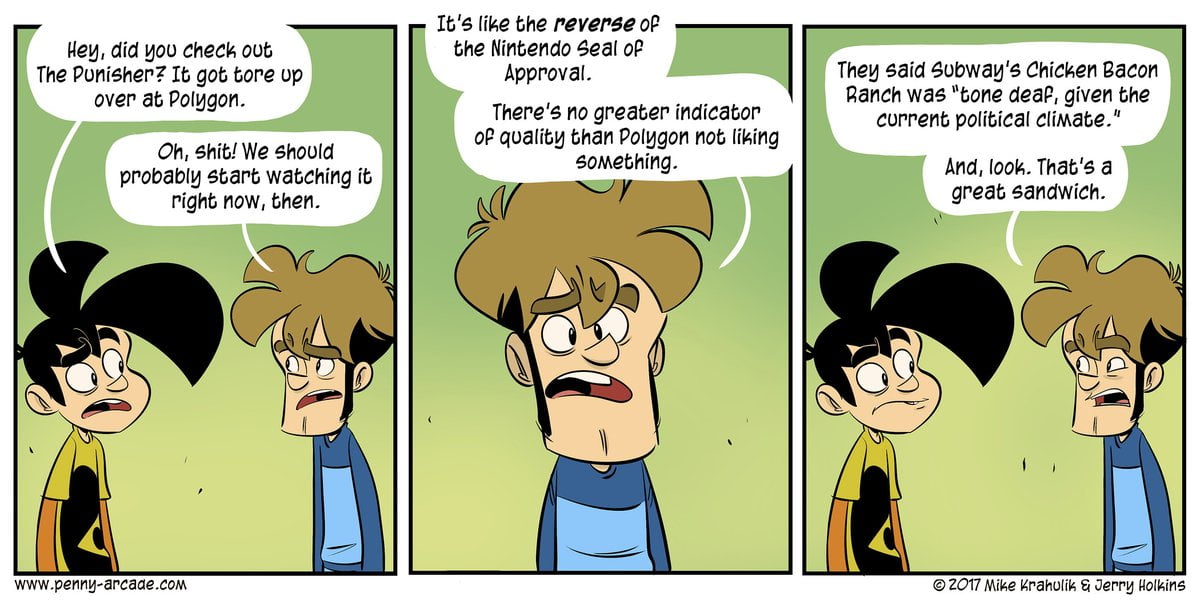
Bullet Journal Module: Day Tracker For The Swindle
![]()
The thing I’ve come to really love about Bujo is the question ‘what is that for?’ can always be answered with ‘the things I want to use it for.’ This is a module I made for my Swindle runs; I want to try and get a run faster than my 16 day current best, I want to know how long I spend in each zone, and I want to know how much influence the ghost bonus/multiplier and number of computers influence what I’m doing.
So I made this!
The note of K vs D: K are runkiller levels, places where there’s simply too much in the way and the day has to be considered a total waste, not even able to advance multiplier. This is when you get things like computers in areas you need bombs to reach before you can possibly afford bombs, or multiple security-locked computers before you can get security hacking. D however is just when you heck up and die.
MTG: Kaho For Ted
I have this friend, Ted. I’ve mentioned that I’m fond of Ted. One thing Ted likes doing is playing Commander. And one day, Ted, Ted mentions to me that he’d like to make a commander deck about Archivists, because he works as an archivist.
So let’s talk a little bit about Kaho.
Kaho, Minamo Historian is one of the legendary creatures from Saviors of Kamigawa. She’s a creature with almost no offensive capability, she doesn’t protect herself, and she has to untap to do anything.
Kaho kinda sucks, but she sucks interestingly.
Doctor Scaramanga’s Wild Ride
Five years ago, I spoke about myself very differently.
Game Pile: Torchlight
If you’re a fan at all of having pets and stabbing monsters, well, we have a classic for you right now.
Continue Reading →
Hyperirrigation
Originally this was just going to be a short note about this curious term I’ve become used to using and relating the anecdote of when I remembered hearing it, and therefore, where I learned it, because it’s a good word. I like it.
The notion of Hyperirrigation is the idea that it’s something that encourages something that doesn’t need it. It’s like watering kudzu, or fertilising bamboo in the hopes it’ll grow even faster, plants that themselves do not need that sort of encouragement (in the environments I’m familiar with them). It’s a word I thought I learned from Christopher Hitchens, describing his view on American Objectivism – that it was a hyperirrigation of the cultural attitude towards selfishness.
I went to find the quote so I could put it in a neat little sconce and share it and appreciate just the word and its contributary nature as an idea while I was sharing it. You know, removing from the totality of Christopher Hitchens, a man who was pro-Iraq invasion and thought Margaret Thatcher was hot, and instead just showing the interesting word he played with and the idea he used it to express. Because even jerks can use words well (and indeed, understanding the wholeness of the jerks who do is a useful tool for understanding people).
And then I went looking for the quote.
And I couldn’t find it.
I did find something similar, but it lacks the word.
“I have always found it quaint and rather touching that there is a movement [Libertarians] in the US that thinks Americans are not yet selfish enough.”
Straight up, I don’t know where I learned this word. What’s worse, is that looking for it, it seems more of a medical term as it relates to nasal irrigation, which is interesting but you don’t want to do an unfiltered google image search for it, trust you me. This puts me in a strange quandrary – because if I didn’t learn this quote from Hitchens as I thought I did, did I invent it? Surely not.
And thus, I share this thought with you. I’m sure as soon as this goes up, someone will happily tell me where they heard it, and it’ll all be solved.
Making Fun, Episode 7 – Getting Started
Hey holy heck I made another one of these!
This time the challenge was learning the tool. I feel a lot more confident with Vegas studio and learned how to overcome a couple of really embarassing early problems.
If there’s anything you want to see me explore as a topic, please, lemme know!
Story Pile: My Two Pennies, Part III
Marshal McLuahn as any Canadian will tell you, codified the idea that the medium is the message; that modes of communication are greater than the ideas that we communicate with them, changing infrastructure around them. Consider this:
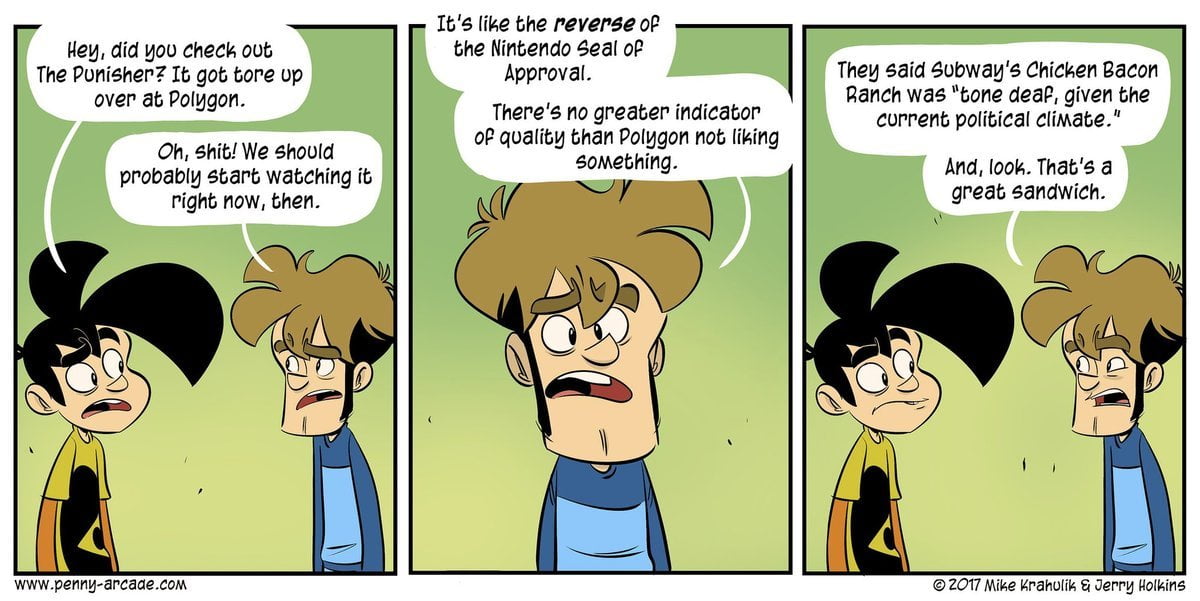
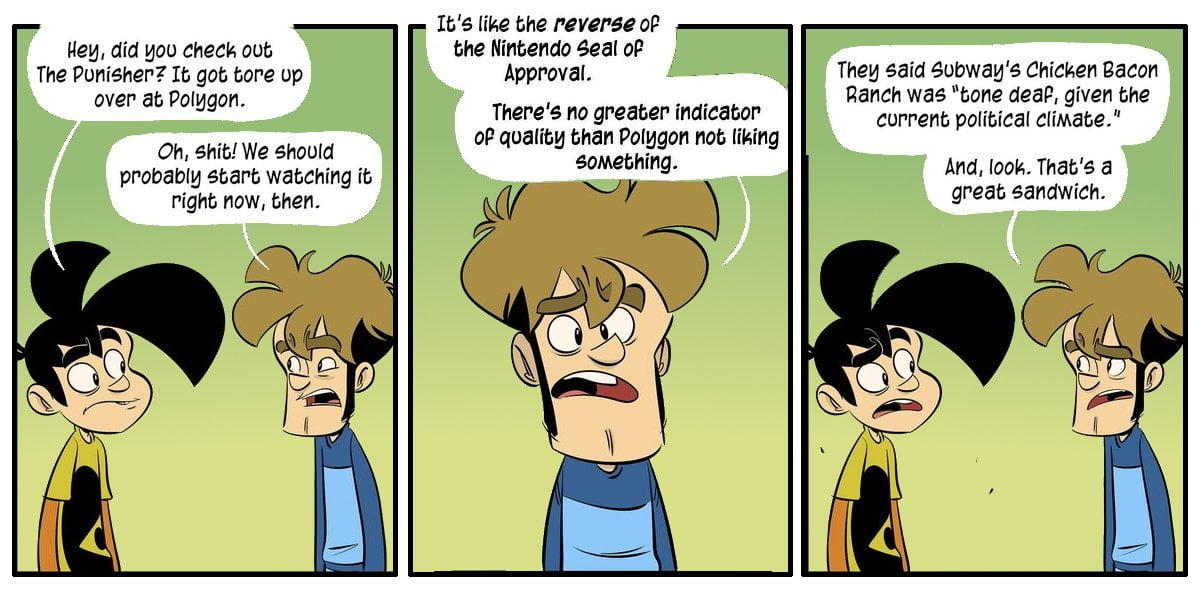
One of these is edited in some fairly inconsequential ways. One of them is the original. Any serious scrutiny will tell which is which. But could you, without the comparison, tell easily what was ‘wrong’ with the strip?
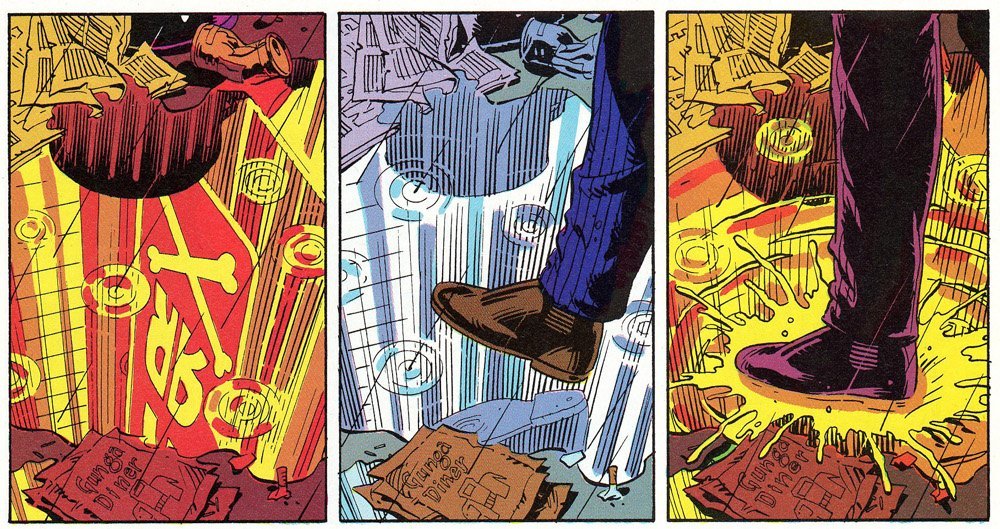
The comic panel is a visual medium that allows us to convey a wealth of information through single slices of momentary time, instances where we do not see animation but its cessation. A panel invites scrutiny and we construct time through the transition of panels.
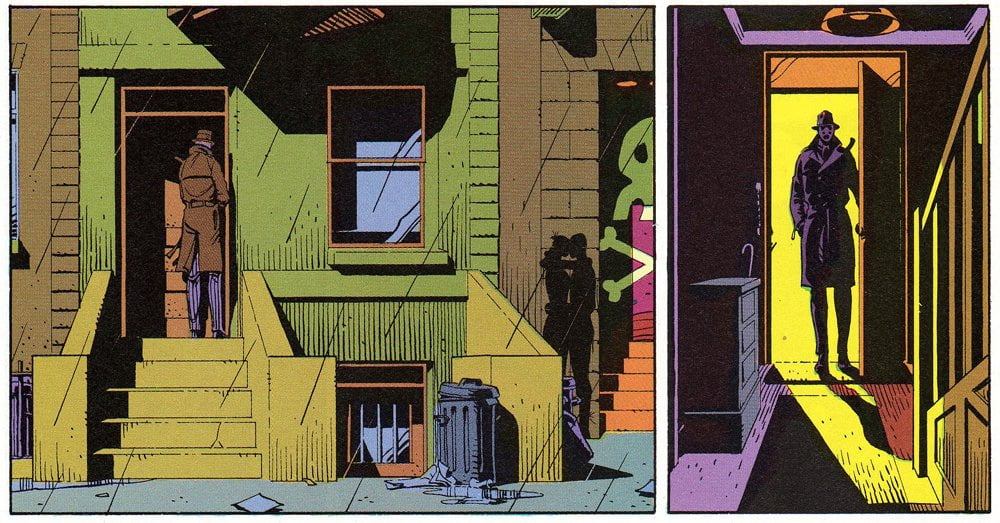
A man opens a door, a wide panel showing much of the street; a narrow panel, showing little, focusing our attention. The second space becomes smaller, threatening, and the man becomes less distinct. We observe him then we become the observor he approaches.
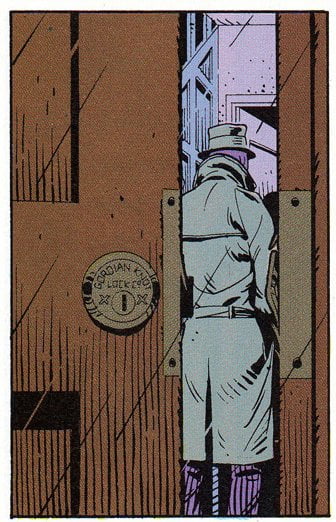
Narrower still. A frame within a frame. We are observing the man moving away from us, within the building now (look at the stairs), a neighbour peeking out. He is not unnoticed. He is not unfeared – even as we know nothing about him from this. I am not, I want to underscore, saying that Penny Arcade needs to be Watchmen. But Watchmen has in it valuable lessons about how comics work, what comic panels do and how you can use them. Moore famously wrote entire pages of description about world, setting, tone and the space of each panel so that Gibson had the tools to actualise the right visual atmosphere.
Here now is literally every single thing that needs to be provided to convey to an artist the information in the PA strip:
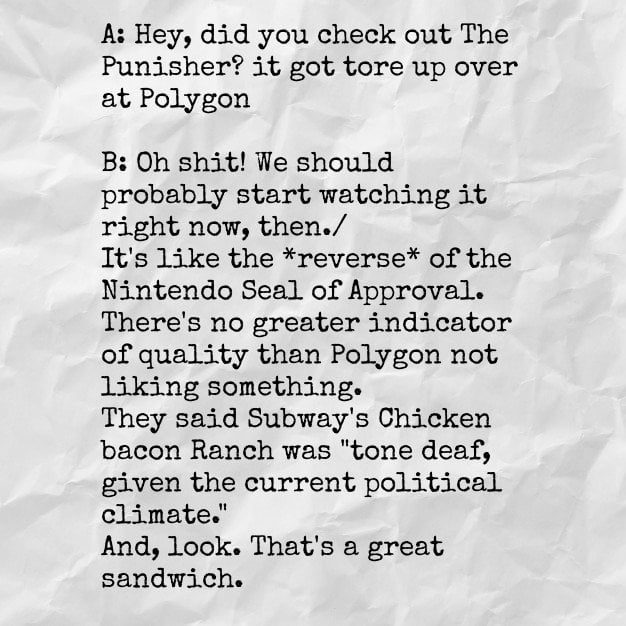
here is that exact same idea:
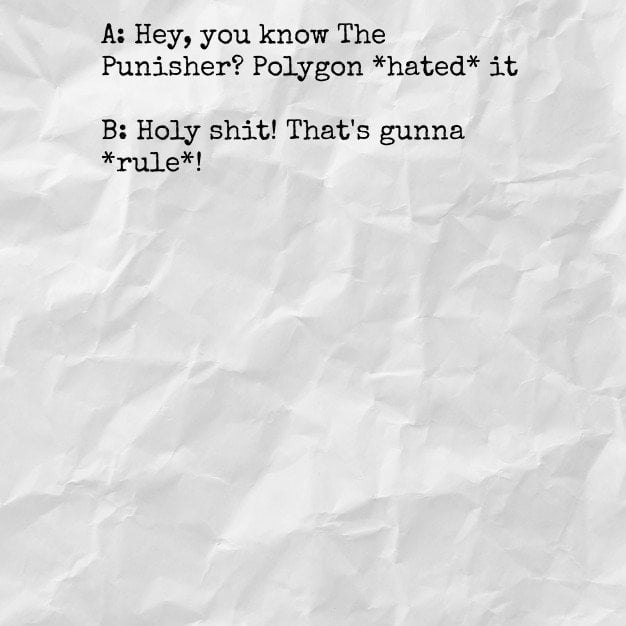
Now here’s the funny thing. Penny Arcade know that this is a bad way to do comics. compare and contrast, 2000 to 2012
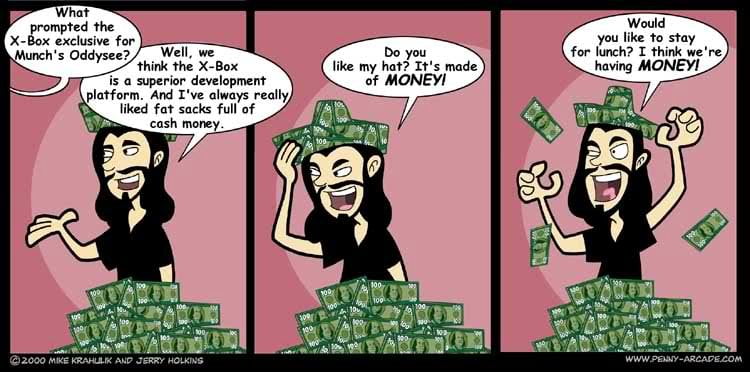
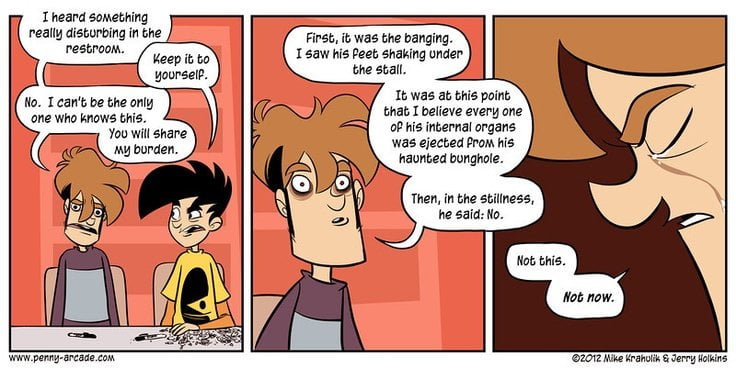
The first one is just the same joke held for three panels; effort was done to re-draw them but they only show a degree of animation, the enthusiasm for the Hat Of Money that, y’know, we’re all learning, I’m not going to complain and the line was pretty funny at the time.
The second one is, like the first, basically a monologue, but they use the cinematic space of the comic panel to do something. You get an implementation of the art: Setting, diner, public space.
Tycho’s haunted expression, closing in on the face.
That near-reverential moment where he closes his eyes
and struggles to vocalise what he has learned,
what he has experienced.
What this has made of him,
what he has become.
It’s a poop joke.
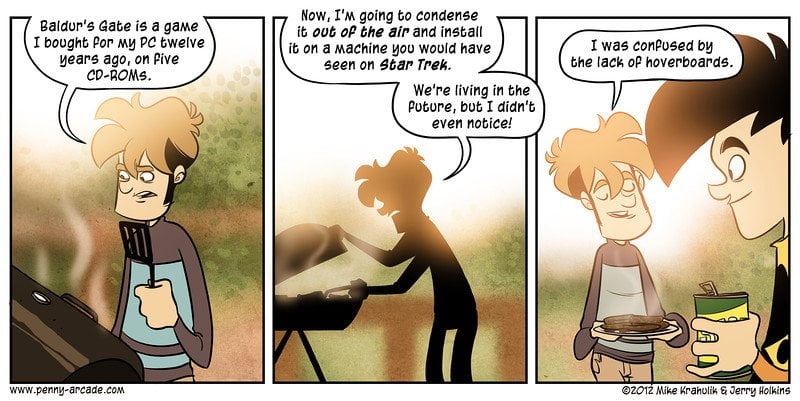
Now here’s a similar application of the idea: The camera conveys that this conversation is slow and peaceful, that there is a pastoral gentleness to this comic. It’s not funny but it is warm and nice and I don’t hate it.
Maybe this was just a lazy day. Maybe this was just one day where they decided they wanted to spend 68 words (not even nice) to make a 10 word joke. A 10 word joke they’d made before! It’s like the most basic of gamer jokes, following only after That Person Didn’t Understand Our Jargon, Therefore We Must Overreact Massively. This strip is just Genesis Does What Nintendon’t for arseholes who don’t like Polygon.
I don’t know what comparisons YOU want to make about Penny Arcade, but here’s mine:
They’re Garfield.
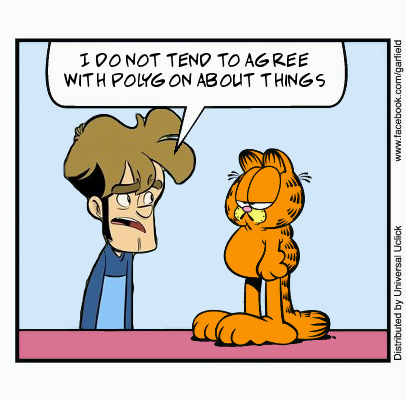
The comic as a medium is visual. You can do talking-head dialogue if you want, and lords knows a couple of millionaires are entitled to phone it in on a day to day basis. It’s only poor people who get graded on the quality of their work.
The strange thing is, that as a projection of its author, of the things that I feel this comic is trying to do, I feel this comic very deeply. I feel it because I know I want to do the same thing. I know that I love the feeling of a rolling avalanche of Oh BURN! of mocking someone over and over, with multiple hilarious off-the-cuff comparisons. You start with something small and dismissive, then you double down and then you double down again and again when the sheer depth and quantity of your endless riffing becomes, itself, a source of comedy. It’s an amazing moment!
Then imagine going home, sitting down, working all day on that rolling avalanche of burn, coming up with your list, then getting an artist to make a visual for it for which you had NO ACTUAL NEED, and put it before your audience
And it’s this.
L’esprit de l’escalier mécanique.
Print and Play: Adventure Town, Pt 1
I saw this one winning the poll ahead of time so there’s been a bit of work on this idea from the getgo.
MTG: Standard Cards I Can’t Make Work
Standard right now is weird. I don’t mean the bannings.
What I mean is there are cards that feel like they belong in 60-card formats that I just cannot make work.
Sometimes cards are reactive and it doesn’t matter if they don’t work because they’re there to do something if someone else is doing something. Things like [mtg_card]Authority of the Consuls[/mtg_card], or [mtg_card]Crafty Cutpurse[/mtg_card], these are cards that exist to respond to things other people are doing. There’s an assortment of aggro creature swarm cards that are for more casual play and usually for limited, which is also fair. But that’s not everything going on.
Here are some cards I really wish I could make work in Standard.
[mtg_card]Dusk // Dawn[/mtg_card]
What kind of decks want to blow up the world? Control decks! What kind of decks want to pick up a lot of creatures? Decks that lose all their creatures! These two ideas work kind of at odds with one another.
The best shell I could find for Dusk/Dawn is sort of a human enter-the-battlefield deck, with Fabricators that let you go wide to avoid a Dusk or stand tall before one to hold the ground better. Mana gets tricky for this design. Also, one of the best cards to work with it, Angel of Invention, makes all your 2-power creatures die to Dusk which is just annoying.
The other problem is it costs five. Being able to go one drop, two drop, three drop, something, wipe board to get rid of your opponent’s stuff, leave my stuff intact is kinda appealing, but in the cases that will win you the game it is also almost always the same as if you could cast a removal spell on your opponent’s blocker.
It’s a nice grindy spell for longer, slower games so controlling Commander decks will love it.
[mtg_card]Kefnet the Mindful[/mtg_card]
A three mana 5/5 is desireable if you’re aggressive, and an indestructable blocker is desireable if you’re midrange. Kefnet would have been really good back in Ravnica Standard for mid-range decks, as a sort of Simic deck aggressor, someone who can stand in front of 3/4s and 3/3s is pretty good.
Kefnet is however, much more of a Kamigawa card. We had the Wisdom mechanic back then, and that mechanic – get seven in the hand or your creature will be bad – and I tried to make it work, but oh god it did not work.
Kefnet doesn’t give you enough early, can’t hold the ground in the early game almost by definition, and the activated ability is cute but also mana hungry. Still, a handy 3-mana enchantment that draws cards better than [mtg_card]Treasure Trove[/mtg_card].
[mtg_card]Trial of Ambition[/mtg_card]
Ughhhh I wanted this to be good! I wanted this to work!
Okay, so like, card draw is this thing we venerate in Magic. Just drawing more cards is almost seen as a good thing. But what if you had a card draw spell that guaranteed you could draw [mtg_card]Cruel Edict[/mtg_card] in a removal deck? And sometimes it can draw you two or three Cruel Edicts?
The problem is there’s no good Cartouche to line up with this Trial. I’d want one of the cheaper ones so you can have a turn that goes Cartouche-Trial or Trial-Cartouche-Trial without it being unreasonable. The cartouche best suited for a control deck is the white one, which also gives you a creature to drop it on, but you still need something to sit on the board and survive. Now don’t get me wrong there’s kinda a sick one-two punch of dropping a creature, forcing your opponent to extend more threats around it, that means you can go Trial, Cartouche, Trial back to back and that’s kinda cool?
But what kinda creature are you going to Cartouche to start with? What benefits from it? What is safe enough you don’t have to worry about it dying on the way? You could maybe go blue and hexproof up a token or two? But those permanents aren’t super reliable either!
It’s just a bit too bad. You don’t want to play Trial of Ambition in a deck that can’t rebuy it, because then it’s just [mtg_card]Diabolic Edict[/mtg_card] which is a bit Not Good Enough but it’s really just, at best, Wildly Okay with one cartouche in a threat deck. It’s not even generally disruptive enough to support a midrange deck.
On the other hand, it is a pretty sweet card to include in a UB [mtg_card]Cloudstone Curio[/mtg_card] deck with [mtg_card]Reality Acid[/mtg_card]? 3BU to blow up two permanents is pretty cool.
[mtg_card]Scrapper Champion[/mtg_card]
One of the things I like about Energy is it lets cards affect the board with a sort of pseudo-haste, which means at any given point in time, a creature’s behaviour could fuel itself, or fuel something else. With the hit Temur Energy took a few months back, most of what kinda makes this deck fade isn’t so strong any more, but I like this card as a top-end beater for an Energy deck.
Part of what keeps it from really singing though is that Green and Red aren’t bleeding aggressive things that gain energy making its Energy supply more of a burst. [mtg_card]Rogue Refiner[/mtg_card], for example is a good card but in the wrong colours, and while there are some nice Green cards that Just Get Energy and aren’t bad, they’re mostly overshadowed by the better cards that Temur would run. Even [mtg_card]Aetherstorm Roc[/mtg_card] is kinda just a better version of the Champion – less explosive, but better able to control itself and able to generate more Energy after its single burst.
I think there still might be some skin there – particularly with Decoction Module and Fabrication Module – to feed into creatures like [mtg_card]Longtusk Cub[/mtg_card], [mtg_card]Voltaic Brawler[/mtg_card] and the top end of the Scrapper Champion, but then you’re back looking at [mtg_card]Bristling Hydra[/mtg_card] and [mtg_card]Aetherstorm Roc[/mtg_card] and wondering if they’re not just better?
[mtg_card]Deeproot Champion[/mtg_card]
I’ve played with [mtg_card]Quirion Dryad[/mtg_card], and I’ve played with [mtg_card]Vinelasher Kudzu[/mtg_card] and really, if you print a 2-mana creature that can get more counters on it I’ll try it. Deeproot Champion is a sort of awkward creature in that it isn’t really strong enough to support a deck on its own but it’s also not really got any complementary threats. Prowess creatures want you to play in a big burst of spells, and don’t like it you play them off-turn, but the Champion lets you play a sort of aggro-control game.
Turn two champion, attack turn three with mana up to protect it or mess with your opponent’s plan is pretty sweet, but it’s not enough to build a deck around and it’s not like the rest of the merfolk’s tribe actually supports it in this plan. You want cantrips and free spells to really make this sing and, well, there just isn’t that support either. The best card to go with it is [mtg_card]Opt[/mtg_card], and the pool dries right up after that.
You can try and add to it with token threats and sort of mix up a big beef/go wide combo strategy, with cards like [mtg_card]Queen’s Comission[/mtg_card] and [mtg_card]Legion’s Landing[/mtg_card], but that feels a bit weedy. If you’re trying to plant outsized threats and ride them in a ramshackle way to the finish line you probably want bigger threats for the price. If this card’s going anyplace it’s going there in modern – and you can’t really make a deck out of it in commander.
Panharmonicon
And finally, Panharmonicon. If you set it up so it does something the turn it comes down you’re sort of locked into an artifacts-matter shell, which can do some kinda neat things but they’re not quite strong enough. If you try to make it so it benefits creatures with ETB and live the dream with Cloudblazer, you’ll find you don’t really have enough creatures to support a deck that can live long enough to play Panharmonicon.
Interestingly, my first attempts at this deck used Dusk/Dawn.
We’ll see if the coming weeks bring to light some tech I haven’t heard of. Maybe not. Maybe the flush of attention to Modern will have some sort of interesting development. Either way, here’s a salute to things that Don’t Seem To Work (Yet?).
The Art Of Your Normal
Confederate monuments are not monuments to history.
Well, they are, but that’s not what they are.
Every single work of art chooses what not to depict. Like every single map chooses to leave out details in order to represent the information it cares about, every single artwork has to choose a point to stop telling you what surrounds it. And Confederate monuments aren’t about the history that is.
They’re about the history that some people wishes there was.
Look at them. Look at how they present the people and events. Heroic struggles against a foe, a very unspecified foe, for an equally unspecified reason. As the Lions of British public works fail to remind you that the Lion is not native to England, and in fact, the people of England did a lot of harm to the places that have Lions, the image and the icon were taken for their own expression, for what they could make people feel about what they wanted to be true.
Now, I want to show you an example of this kind of art, but presenting this art without context inherently allows the art to speak for itself. So I’ve made some subtle annotations to the artwork so you can focus instead on the art as an object of intention, that it was something someone constructed and why they did it. You know, rudimentary postmodernism, questioning the base assumptions of our art.

The soldier is presented with a raised foot, holding a weapon, looking nobly at the future; the figure is shown as powerful, whole, is constructed and crafted in a single colour but with shapes that suggest the blowing of wind, the vivacity of life cast in metal and stone. There is an inscription full of importance and vigor, in the language of our culture’s view of Value.
This is propoganda.
The Public Art of the Confederacy, which presents soldiers alone, in positions of glory, and valour, and success, are presented as skilled and noble. They are in uniform, they are standing at attention, they are glamorised. You don’t get statues showing them throwing black infants into a river; you don’t get the statues that show these people as part of long-term and constant genocide. The history that you’re seeing, then, is not the history of what happened, but rather a tiny, tiny window into something that did happen, and by ignoring everything else, a dsesperate aim to keep the rest of that information hidden and lost. Let these people look noble, and do not think of every single round they shot, every wound they took, every personal deprivation was in the name of continuing the generational torture of Black Americans.
There is a generation of Southern Americans, growing as the conservative movement carries this vile meme with it, who are convinced that The Confederacy Wasn’t That Bad Actually and this art is part of why. These statues, these statues to men and women who hate America, who stand proudly and nobly against the American ideal of No Slavery, they are art that wants to make their evil normal, and acceptable, and calmly casual.
Your art shapes your world.
And this art glorifies evil.
If you want to keep it around, if you’re against the idea of the destruction of art, which usually is used as a way of examining art as inherently intransient, which is its own problem, but if you want to keep this art around, then you owe it to your culture to put it in context. Surround these statues with monuments of the lynched and slain. Add plaques commemorating the invisibly dead who did not get to be valorised in death because their crime was being born into a black skin under someone else’s ownership.
Or tear them down, and put them in museums, the Ways We Try To Forgive Ourselves For Genocide Museum.
Game Pile: Strong Bad’s Cool Game For Attractive People!
It’s no secret that I have Opinions about the golden age of adventure game, which is to say about 1985 through to 1995, the period when the genre of moon-logic point-and-click PC games expanded, explored, then catastrophically collapsed. But while having that grounding in the genre is useful for being able to speak authoritively about the way the genre developed, it can sometimes suggest that there are no games out of that period that did it well.
Well, let me tell you about an amazing point-and-clicker from 2008.
Continue Reading →The Traits Of Objects
You may have heard about the idea of ‘objectification.’ When I wrote about Daredevil, I trotted out a list – Instrumentality, Agency, Ownership, Fungibility, Violability, and Subjectivity. Where’d that list come from? Is it a tool you can use for your own writing?
One of the things I like with critical tools is that you can turn them on work that exists, and illuminate traits of the work you wouldn’t otherwise notice, but also, like an inverted puzzle piece, you can turn the tool on a work you’re developing yourself, and in the process, see spaces you can use to fill things out to achieve what you want. In this case, the tool is useful for avoiding the objectification of a character, which is to say, you can use this checklist to imbue a character with character.
As for the list’s origin, it’s from the work of Martha Nussbaum, and her writing was about people, not about media. It was also expanded by Rae Langton – whose work primarily focuses on sex and pornography. I don’t have a strong grounding in either of these creators, and I have the nagging feeling that digging into the views of a pair of 50+ year old Feminist Philosophers will find something nasty and TERFy. So don’t take my appreciation of this tool as an endorsement of them.
The full list, including both Nussbaum and Langton’s categories, and the questions they ask, is as follows:
- Instrumentality: Does this character exist to only enact the purpose of another? Are they a tool? Could you replace them with a vending machine?
- Agency: Is the character ever demonstrated as having their own purpose, their own ability to make decisions for themselves?
- Ownership: Is the character ever depicted as being literally the property of another? And if they are, is that depiction ever showing that as being reasonable? Parents, for example, are often depicted as owning their children. How do you think of that relationship?
- Fungibility: Can the character be swapped for another character of a similar type? Is the character replaceable? How would the actions of the character differ if another character was called upon to do the same thing?
- Violability: Can people act on the character without consequence? Can you punch them with no followup?
- Subjectivity: Does the character’s individual experience and personal opinion ever matter? When they disagree with someone is it because of a personal interpretation of events? What fuels that thought?
- Reduction To Body: Can the character be thought of as just a particular component of their body? Are they a fist to attack someone with, a foot to step on someone? This is very common in pornography – is a character, for lack of a less crude term ‘Tits The Girl?’
- Reduction To Appearance: Does a character matter primarily in terms of how appealing they are to the senses? A good test of this again, is to check how these characters could be organised in terms of being ‘the hottest’ or ranked for appearance.
- Silencing: Is the character voiceless? Are they treated as if they are voiceless? Does it ever matter if they say anything? Do other people react to what they have to say?
Sometimes there are some really weird things you can get by applying this toolset. For example, lots of the characters in Joss Whedon’s work are fungible – they almost all can say the same lines of dialogue. Zack Snyder’s Perry White in Batman V Superman hasn’t really got Subjectivity – he exists to oppose Lois Lane’s efforts, without a justifiable rationale for doing so. But you wouldn’t necessarily assume that Perry White is objectified as much, in this case, as he is just an object.
Not every character in a story needs to be a non-object. There will always be room for goons and audiences and randoms. Stories thrive on having objects in them. The thing to look out for in your own work is if all the objects you’re using have common traits – if all the black people in your story, for example, are fungible, you probably have a problem. If when you need a random character to dismiss as being meaningless, you reach to make it a woman, you’ve got to wonder why you keep doing that.
And also knock that off.
This list also makes a valuable way to examine your characters and see if there are new ways you can add dimensions to them. Make them more real. Just recognise that sometimes, a messenger can just be a messenger, they don’t need a backstory and a family and seven layers of motivation if they’re going to turn up and tell you that Rosencrantz and Gildenstern are dead.
A Tale Of Three Tales: Atilla Ambrus
The story of Atilla Ambrus is like a movie. No, not quite. It’s like three movies.

Story Pile: My Two Pennies, Part II

Last time, I took this Penny Arcade strip and explored how it conveyed its message, and what it was trying to say. We wound up at this: 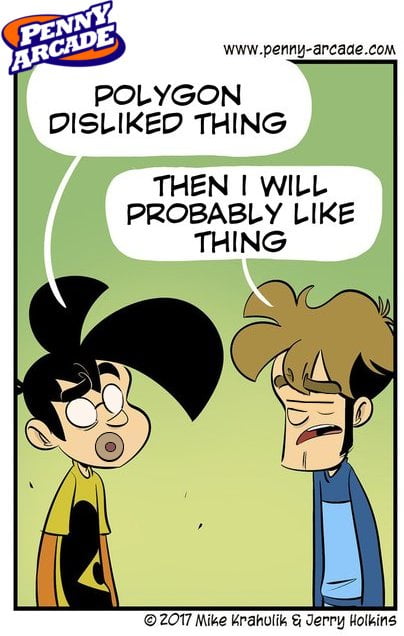
Here’s that panel with like, the miscellaneous random crap and a bunch of weirdly unnecessary face lines cleaned up just because I find that strikingly different.
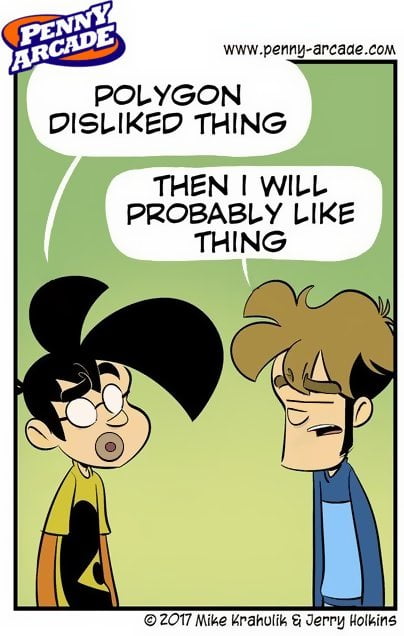
Penny Arcade as a brand is estimated at being worth $37,900,000. They do not, I am absolutely sure, care a whit about what I have to say about their work, unless I somehow catch one of them on a randomly spiteful day, which I am pretty confident I won’t. Plus they have the raftload of excuses – this is how they do things, this is their art style, this isn’t made for critics, they don’t care, they’re extremely not mad – that anyone can use when their webcomic is mocked.
The amazing thing about this clearly great, great comic, is that there’s so many ways it can be used to tell the exact same story, the ways it reinforces and multiples upon its own intricate, endlessly deep thesis. 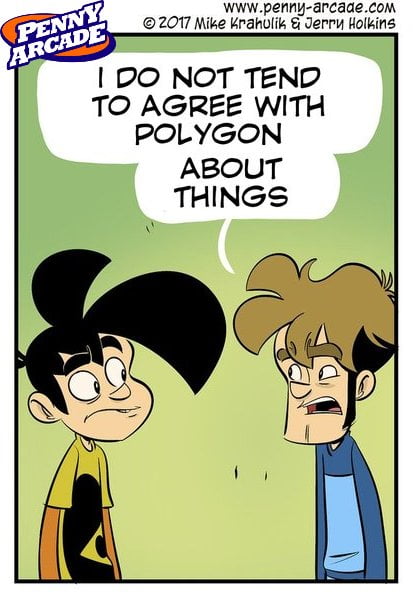 Such a confidence and absoluteness in its message, so coherent and deliberate in its overwhelming reassessment of its meaning, it is the only work that knows itself, that knows what it is for, what it means to say. As art, it proves to us that it is real – and we, ephemeral.
Such a confidence and absoluteness in its message, so coherent and deliberate in its overwhelming reassessment of its meaning, it is the only work that knows itself, that knows what it is for, what it means to say. As art, it proves to us that it is real – and we, ephemeral.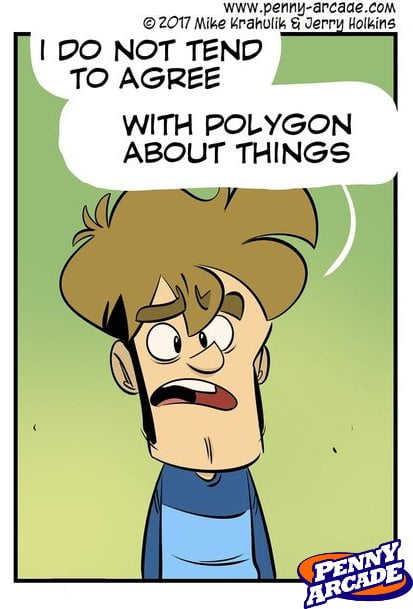
When I am gone, this art will remain, perfect, unchanging, a message unto eternity, perfect in its affirmation of what it, more than anything else, knows to be true:
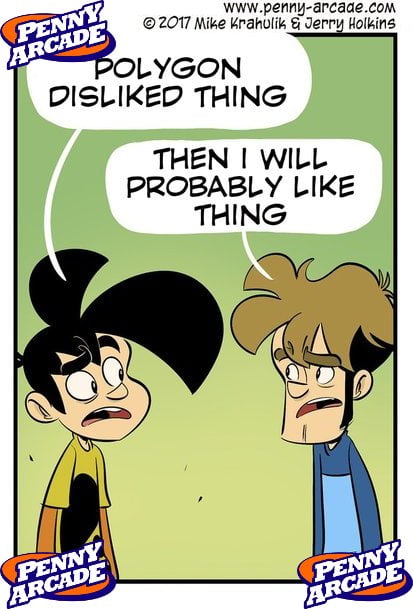
it’s like you get three individual comics at once! Then, wrapping it up, you’re presented with one big comic that is itself, made up of three individual comics each saying exactly the same thing of its own opinion. It is postmodern in that it challenges the assumption that a comic need have a structure, that comedy need be funny, that there needs to be anything else in life but spite and disdain for the other, and that you can use a position of media prominence to do nothing but snipe needlessly at things you assert that don’t really care about.
It is a russian nesting doll made of Pickle Ricks.
Which is a thing that exists.
Thankfully, we will always have the branding we can wear, with which we will adorn ourselves and show that we, more than anyone else, care about this art. Oh, how we care.

Print and Play: Finding Your Boundaries
With the launch of My Patreon (which I launched this month you should check out my Patreon), one of the questions I have had to struggle with as opposed to my compatriots on the service is what service I offer that’s entirely digital. I make videos and blog posts – which I love doing – but games, card games and board games – they’re pretty tricky to shift digitally.
But there is a dark art for tabletop games, an art that is mysterious and strange, where no physical property passes between us, my reader, but you still get a game and you get to have a physical object in your house you like that makes you happy, and I don’t have to like, mail it to you. And this is the dark realm
of print and play.
Print and Play is something I have ‘technically’ done. I have a couple of games which offer pdf downloads for print and play – games like The Botch, Dragon’s Favour and Push-Pins are all available as print-and-play games. Push-Pins is a bit of a special case and we’ll talk about it later.
The premise of Print-and-Play is pretty simple: Rather than sell people printed cardboard bits and pieces, I sell you the files and you print them out yourself to make nice cardboard bits and pieces. There’s a lot to like about Print-And-Play! Some quick thoughts :
- It’s cheap! No warehousing, no storage, no distribution costs! If someone wants your game they can buy the files!
- Player control! If a player wants to test a game out they can print it out cheaply and make do and they’re out very little, but if they love it, they can make it fancier
- The player is a primary producer! This means that you can include rules like drawing on a piece or destroying a piece and the game still functions just fine, and if the player wants to reset the game it doesn’t cost them a lot of money.
- The process of crafting is itself fun! Players can individualise how they want their unit to work, decide things like the weight of tokens they want, they can decide how many tokens or markers they want – lots of good stuff there!
It has some problems, too!
- It’s cheap! Players do not spend a lot of money on Print-and-Play, and it’s not uncommon for some games to get their start as Print-And-Play freebies.
- It’s a crowded marketplace for the audience! There are lots of people out there making print-and-play games, so it’s hard to get yours noticed.
- Print-And-Play is often a testbed for bigger releases! This can mean sometimes your amateur game is competing shoulder to shoulder with presentation values you might expect in a big budget game someone’s spent some serious money on!
When I start working in a design space, a thing I like to do is find the boundaries. For example, when we started making games for DriveThruCards, one of the rules was that a game had a maximum deck size, and DTC couldn’t provide tokens. That informed my designs, and that’s why we have our games like Middleware and Fabricators sitting at 120 cards. As we started to use tuckboxes, I started to design to make a game that fit comfortably in a tuckbox – so 54 card minimum.
Before we go into what I intend to do with Print-And-Play (inspired by but not exclusively for Patreons), I’m going to outline boundaries that I can see for designs. Now, I am not a seasoned Print-And-Play designer or player! This is me getting into this space! Fortunately, there are wonderful people on the internet already making these things, so let’s check out an example of someone providing instruction on putting together some nice quality components of Print-And-Play.
Now, I know it’s a long video, you don’t have to watch it all, but I provide it here as a reference.
Here are some thoughts on boundaries:
- The cheapest-quality cards people make for their games are to print out the cards on normal A4 paper and cut them out with scissors. This isn’t good for shuffling and can be hard to randomise. There are a lot of steps up from this, though!
- Tokens can be replaced with all sorts of other things, like nails or toothpicks or whatever, unless those tokens need to convey some play/game information you have beyond marking the presence or absence of a number of things.
- If designing nice tokens, square tokens seem easier to cut than round tokens. Lots of games use round tokens, but there’s no need for them. Hex tokens are also arresting, and fit together nicely, but if you’re not going to make them fit together for some reason, if you don’t need that shape, the hex token seems pretty annoying to cut out.
- You are asking for a direct investment of your player’s time to get the game to work. In some games, you may include things like reminder cards or randomiser cards, or some bitty tokens that track unnecessary things and cost you almost nothing to include. When you’re costing user investment, you want to avoid these things.
With that in mind, what are some things that I can see doing with Print-And-Play?
- Small-card count games. Games like The Botch which only need a small handful of cards.
- Shuffle-light games. As it happens, games with small decks often don’t need shuffling either.
- Single-sided cards. Things like Magic: The Gathering’s double-faced cards or the backs in Downspout or Burning Daylight won’t really work so well
- Tokens, counters, chits and bits! You can have these!
- Mats and boards! A character sheet style arrangement, with a printed sheet with fields a player fills out!
I have some ideas already, and hopefully next week I’ll have some work to show you on this.
MTG: The Mimeoplasm Puzzle
I work in advance which means this article was basically written before Rivals of Ixalan stuff was being spoiled. It might wind up being bumped a few times, who knows. The important thing is, this is a kind of semi-evergreen article where it doesn’t REALLY matter if what I write about is a bit old news, because it’s about a process rather than a play. Still, it might get bumped if RIX shows me something I wanna talk about, though I’m not holding my breath so far.
Rules are Stupid
The D&D Alignment system is nonsense.
This isn’t some deep wizardry here. This is just a really rudimentary fact. The entire system is phrased like it’s a moral judgement framework and there’s been a truly enormous quantity of writing trying to thread the needle of explaining a moral framework that is both simple enough that a game system can handle it, while also making a way of representing actual human interactions that can’t be exploited by the most sophomoric seventh-grade part-time evil dictator.
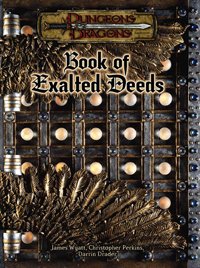
The main lesson of the morality system of D&D is a greater one for designing rules in general, though: Rules are stupid, or rather, rules cannot make choices or judgements. Rules are things humans interact with, they are not capable of making complex judgements themselves. What you want a rule to do is interface quickly with a player asking it a question: Hey, what happens when I do this?
The rule should, ideally, serve as a sort of curve bend in a pipe – player intention runs towards it, and that pipe just directs the player’s intention in the right way, with as little friction as possible.
How does this apply to the Alignment system? Well, largely it means you have to start acknowledging it as a silly rule, and accept that it’s not really going to be a good tool to use to direct player intention. If you have a Paladin who tortures someone and whose player expects their moral standings to stay Lawful Good, your problem there isn’t in game rules, it’s that you’ve got someone in your group who thinks they can justify torturing people as a good thing.
What it means is that you need to approach the morality system as a set of flags: Spells that want to ‘blast evil people’ can be used for dramatic reveals, or things that impede ‘good characters’ from entering should be as simple as a boundary or barrier… but you shouldn’t be using them as a moral system, just as a way to put simplified flags on things.
Or, you know, just ask yourself if it’s worth it to have spells that want to try and make complex moral judgements on the fly?
Game Pile: Duke Nukem 3D
More and more these game reviews are as much a chance to use the game as an avenue to talk about any old stuff I want to so let’s not kid ourselves, that’s what I’m gunna do.
So, Duke Nukem 3D. It’s a mediocre first-person shooter modelled on ‘Doom, but-‘ released to compete with Quake, an equally haphazard game that despite being a failure is still one of best videogames of its decade, no qualifications, no exceptions, Quake is, yes, that good, do not @ me. While id and Raven Software games sought to take a technical engine and wed it to solid fundamental play and design choices, 3D Realms strove to instead build their game with theming, making it all about being the coolest goddamn thing you could possibly be in 1996, and with that, carried the brand all the way into the Sonic The Hedgehog Franchise-Dumpster.
But while there’s a certain fondness that can persist for Sonic the Hedgehog, a franchise that picked up a lot of people when they were kids with ideals of environmentalism and friendship, Duke Nukem was…
Let’s say he’s got problems.
Continue Reading →Monsters
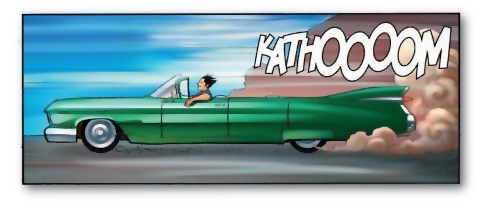
I have a complex relationship with monsters.
Continue Reading →Notes: The Insane Jurassic Park Theory that Might Be True
There’s a bit of a thing about ‘fan theories’ being extremely annoying and stupid (looking at you, Game Theorists), and there being a bit of a … backlash? Sidelash? from other fan commentators dismissing them as fanfiction, and therefore, not worth paying attention to. Me, I think that fanfiction needs to be taken seriously, and this video is a great example of ways it can enrich media.
In this work, we have advanced, forward knowledge of how things work since the original story came out, and some meaningless plotholes and a few character details, extra media from other movies – basically, this theory explains something that was never really intended to be there. On the other hand, this creates an interesting version of the reality presented in the story, and what you wind up with is a richer story with a little shift of characters, a little difference in how we perceive the movie from 20 years ago and now.
This is also a practice I learned in Bible Study: It’s called a harmonisation, when two things contradict one another. You construct a new diegesis with fictive information that justifies the conflict.
Story Pile: My Two Pennies, Part I

I see some people are having a hard time interpreting this Penny Arcade comic, and so I figured I’d try and help you out here. I am, after all, an academic, exactly the kind of person that Penny Arcade love to bash for our difficulty understanding their intricate, street-level Derridan medium, so I figured it was best to conduct some study and provide a clear, explored version of their original text for other people to consume.
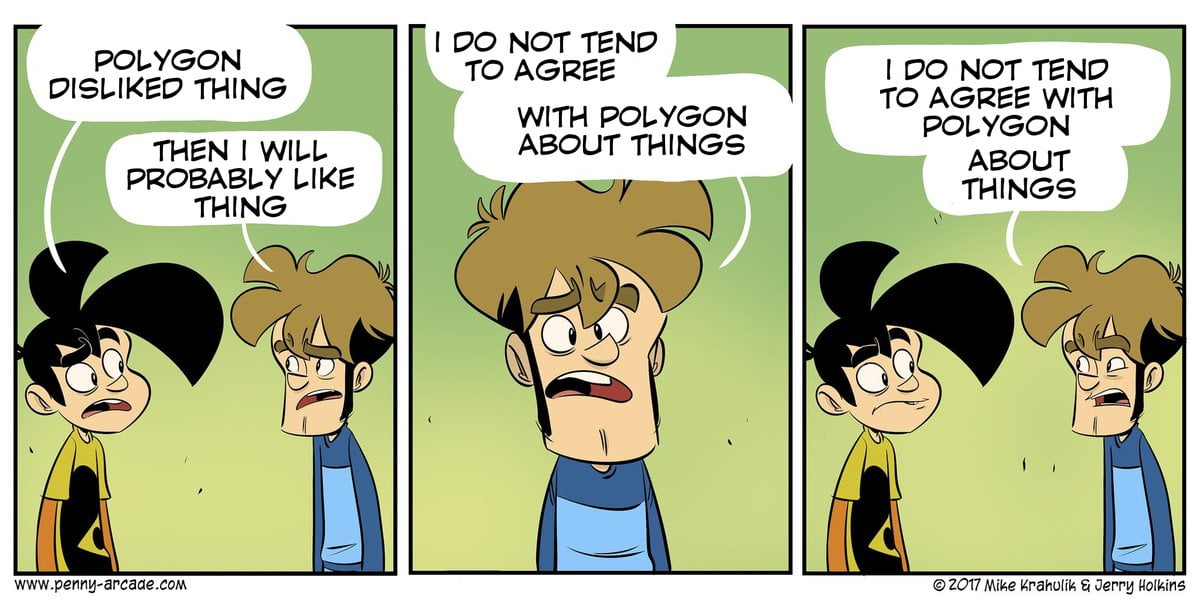
I hope this deciphers this intricate political statement and is worth the years of study. It’s a difficult puzzle to solve, and you can see here how they’ve cleverly used the rhetorical device of repeating themselves three times to ensure that we clearly understand their joke. Now, conventionally, comedy would dictate that you don’t belabour your joke – that you make your point, deliver the joke sharp and smart (like a ‘punch’ line, as it were), but the Penny Arcade magnates are proud and above such things. They instead opt for this very advanced form of comedy where they restate their joke repeatedly.
Some people have argued the original third panel was actually mocking the idea of people caring about politics, which is kind of true, but only in that it’s meant to be mocking Polygon for its daring to care about this as it relates to clearly ridiculous things. That is, they believe that the source, Polygon, is wasting its effort and energy on things it shouldn’t be doing. Like this.
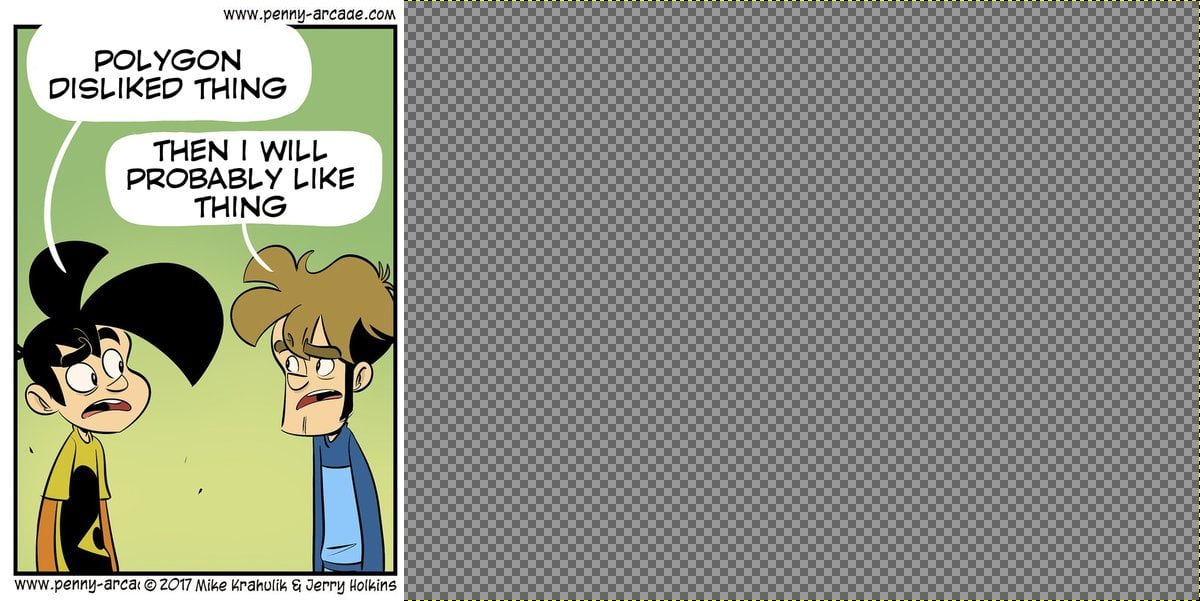
Now, when I see things like this, I think we all recognise that the true greatest genius of 90s comics, and genesis of most webcomic as a genre was the work of Gary Larson in the newspaper single-panel comic The Far Side.
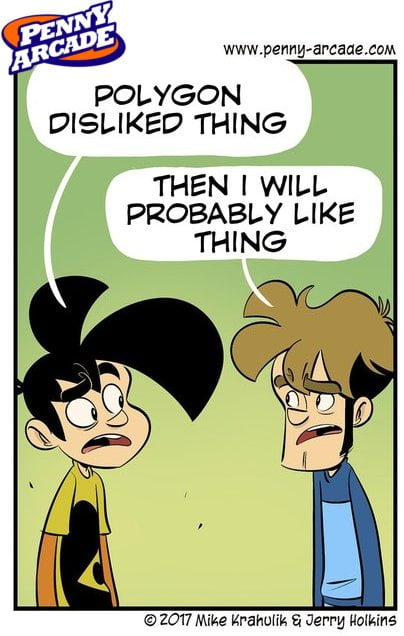
Of course, Larson was a believer in, and advocate for active minimalism in comedy.

It stands to reason when you’re working for an editor and need to turn around your comics quickly for quick redraws and re-works, you might favour a style that’s very clean, and avoids excessive extra lines or notes, and makes the small space you have maximally expressive.
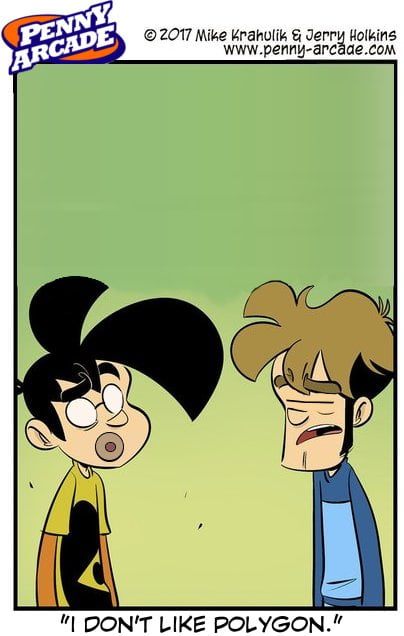
As you refine the process, you realise how little of what you need is useful. You start to appreciate how much you can express with a small number of narrative and visual tools. The chaff you thought was essential melts away and you’re left looking at what you’ve chosen to present, and how, in its purest form. 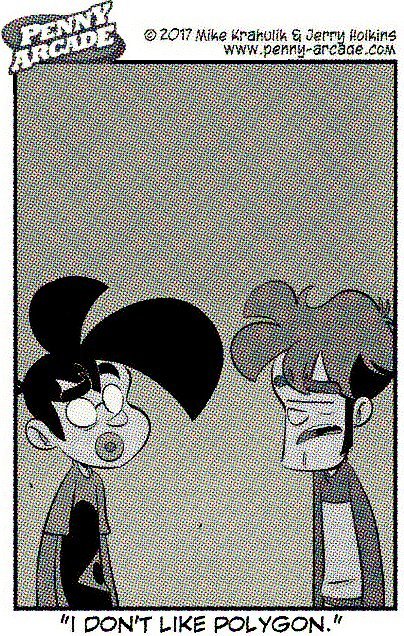
Anyway, I think we’ve all learned something today.
Talen Lee is now on Patreon!
DEEP breath.
Hey folks! Do you like the stuff I do? Do you like that I write about games, Magic: the Gathering, media and everything else? Do you like my guides on how to make your own games, or terminology in games that we don’t use well? Do you want to give me guidance on stuff you want to hear me talk about? Do you want to buy some of our games, but find the shipping costs or the schedule intimidating? Do you want to see me do more podcasting and video stuff? Well, I have some great news for you, because you can now directly incentivise my work and consider yourself invested in it directly, thanks to a Patreon!
My intention is still to make as much of my work free as possible – if I use the Patreon as a content footing, it will be almost entirely for early releases or the sort of miscellaneous poll-or-feedback kind of questions I sometimes use Twitter for. I’m charging it per month rather than per product, and will include such things as group sales and bundle rates for our games.
So please, check it out, and if you can’t afford it, don’t worry about it! If you don’t want to do it, because you think I’m not worth paying for, well, dang, hurtful, jeeze. What’d I do to you? Unless you’re Ryan ██████, I know why you have it out for me.
Anyway, please please please: Check it out.
MTG: The Fake Spikes
Every day, someone learns something new. You may not know who Spike is, in the context of Magic: The Gathering. It’s hardly likely if you’re reading a blog talking about it – I mean, we’ve had a few months since Unstable launched, but still, it’s possible you missed it. Yet if you had, Wizards R&D has a term for player types that recognise how and why players engage with their game as a player. There are three (five, but seriously, we’re doing the first version of this) basic types of player:
- Tammy/Tommy, Power Gamer
- Janey/Johnny, Combo Player
- Spike, Tournament Grinder
These player terms were introduced to the Magic player lexicon sometime around 1998, and in the intervening twenty years, we’ve grown very used to talking about these player archetypes as labels for one another and for ourselves. Tournament reports will routinely refer to ‘spikiness’ or ‘proper spikes’ or ‘hardcore spikes’ or so on. Players will often use ‘spikiness’ or ‘johnnyness’ as metrics of how they play or the tone they’re going to set for a play experience.
Basically, we know these characters and we’re also pretty sure we know what they mean and crucially how they relate to us. There’s an old joke that Timmy, Johnny and Spike all look down on one another for not really understanding the game but only Spike has any right to, which is funny if you’re a Spike and kinda dickish if you’re anyone else but it’s okay because Spike has so few sources of joy in her life.
What I see rarely, though, is examination of players mis-identifying.
The most recent nonsense that came up with Christine Sprankle and the card [mtg_card]Spike, Tournament Grinder[/mtg_card] got me looking at a lot of people who professed they were Spikes, that they were in the game to compete, and who were unhappy that they were being represented by a woman character. And this got me looking at this population – not individuals, because hey, I’m only seeing a tiny window of time for people, you know? But the groupings of self-professed Spikes, who when they encountered a rule, complained about how that rule made them feel.
Isn’t that interesting?
Now, I am not an expert on these things. I am an observer. But to me, the understanding I had when it came to Spike was Spike didn’t care about changing the structure, Spike cared about the structure as a test. Spike was here to show how good she was, to test herself, to prove herself. But then we have all these people, saying they’re Spikes, who reacted, when presented with part of the game, with dissent and distrust.
Timmy wants to experience something. Timmy plays Magic because he enjoys the feeling he gets when he plays. What that feeling is will vary from Timmy to Timmy, but what all Timmies have in common is that they enjoy the visceral experience of playing.
– Mark Rosewater
There are players out there who think they’re Spikes, because they are Timmies, and the feeling they want to embrace is feeling like they’re Spikes. They get mad about their blowouts and they watch the pro tour and they love their victories and they do the things that emulate the actual tournament grind, the way to push themselves through the circular pattern of feeling like Spike. And the thing is, you can tell how Spikey these players really are because of how they react to being challenged.
Spike seeks a challenge. Spike wants to be challenged. Spike, when confronted with a challenge is going to want to engage with it. But when confronted with a challenge as simple as ‘recognise women exist,’ a lot of so-called Spikes didn’t want to engage. They didn’t want to have that idea challenged.
They just wanted to feel important.

 Check Talen Lee out on Patreon!
Check Talen Lee out on Patreon!